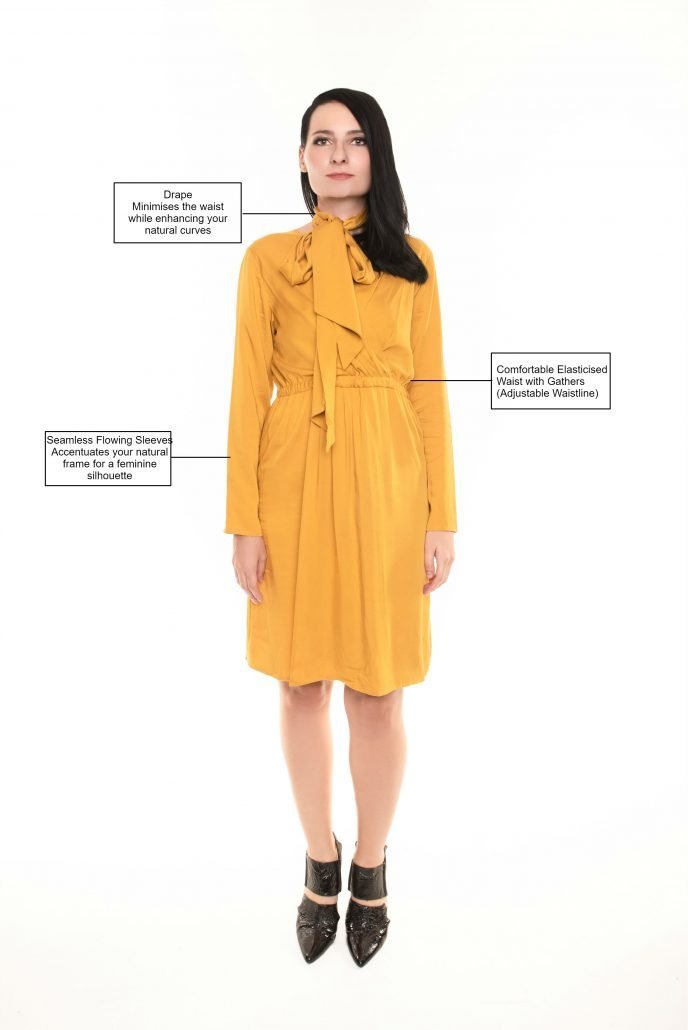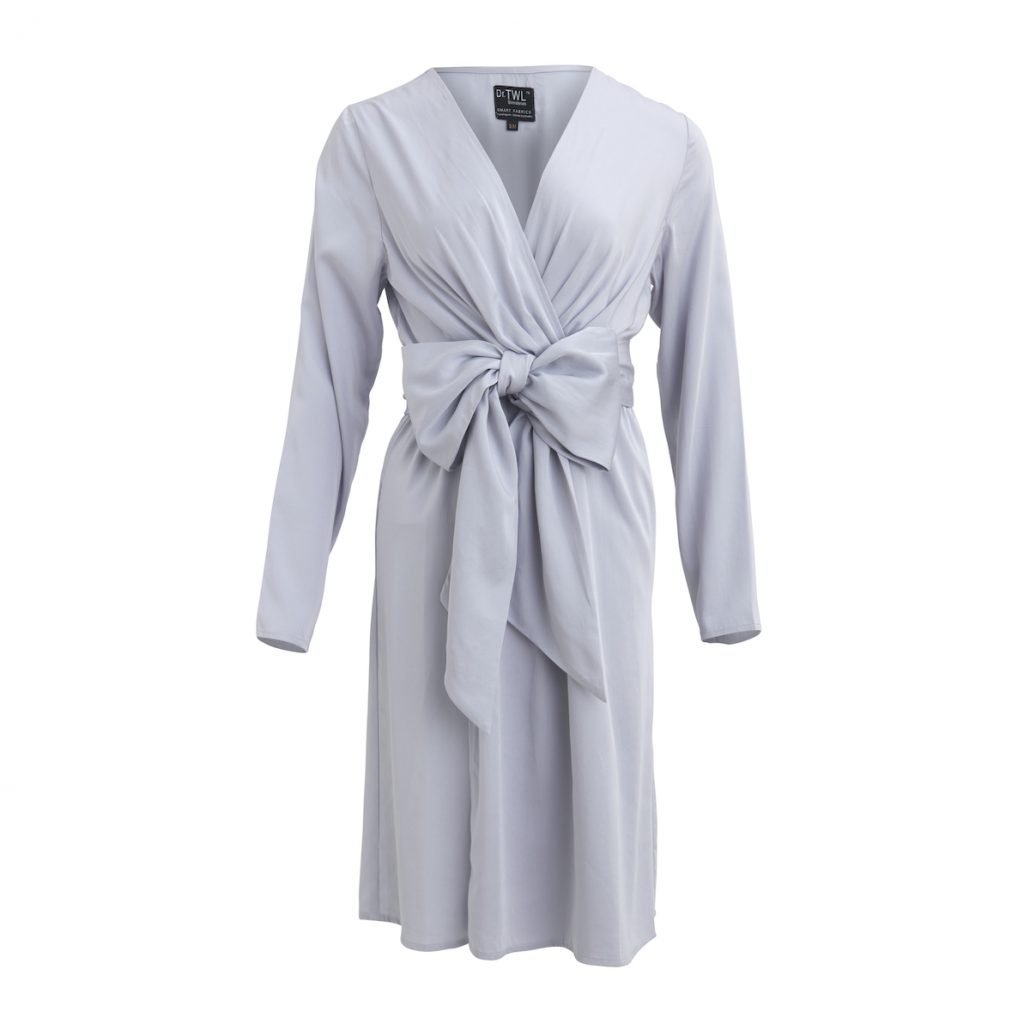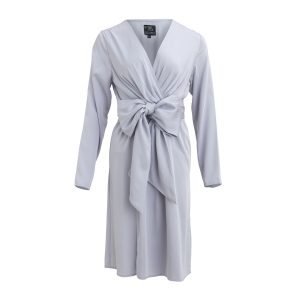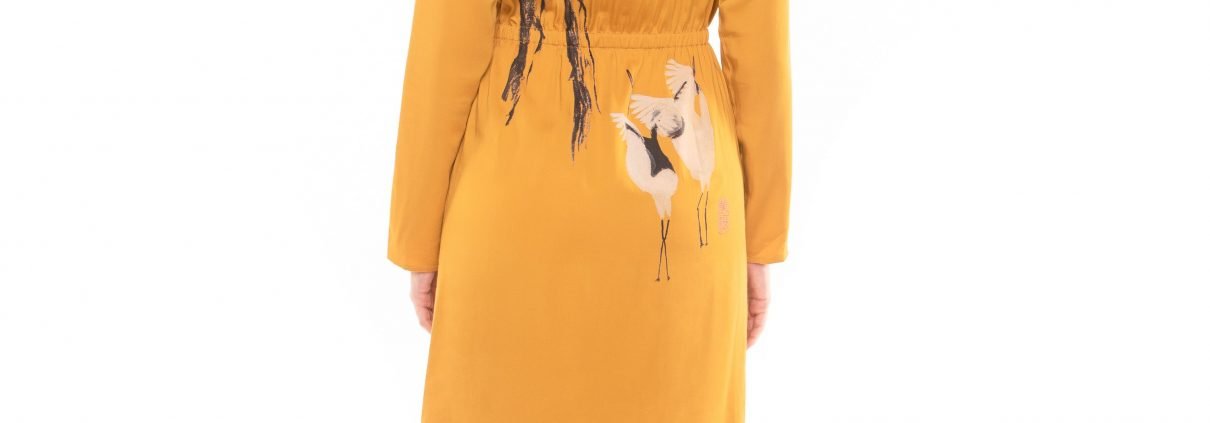Comfortable, Skin Friendly Fabrics for Sensitive Skin
Dr. Teo Wan Lin is an accredited dermatologist and the key author of original published research on biofunctional textiles and the effects of fabrics on the skin microbiome in peer-reviewed journals. She is also the founder of the Biomaterials engineering arm of Dr. TWL Dermaceuticals and the inventor of the original biofunctional textile fabric mask design with UPF 50+, as published in the Journal of the American Academy of Dermatology in her research letter – Diagnostic and management considerations for “maskne” in the era of COVID-19, on October 1, 2020. The CUIONS anti-aging fabric mask was featured in The Straits Times A-Z inventions of COVID-19. Follow her podcast Dermatologist Talks: Science of Beauty on Spotify here.

Dr. Teo Wan Lin wears the LyoSilk Multi-Way Wrap Dress in Imperial Mustard Yellow on the cover of her book, Haircare Bible- Dermatologist’s Tips for Haircare and Hair Loss.
The following is an original article written by the author for www.drtwlderma.com copyrighted 2021. All rights reserved. It should not be duplicated or copied in part or in whole or rephrased by any means without express prior agreement in writing or reference to Dr. Teo’s original published work on the skin microbiome and textiles.
This article focuses on the best breathable and comfortable fabrics for sensitive skin and eczema. My work in materials started with the search for the softest, sustainable and durable fabric beneficial for sensitive skin patients. Tropical Singapore with its high humidity can worsen eczema symptoms, due to heat and occlusion.
This directly relates to the health of the skin microenvironment- which affects the balance of germs including bacteria, yeast and fungi on skin. Sensitive skin is more susceptible to secondary skin infections. This includes pityosporum folliculitis which may appear like body acne. Eczema itself is related to bacteria and yeast. Staphylococcus aureus and malessezia colonisation occurs in eczema patients. There is a super-antigen effect in which the bacteria causes, which drives the immune reaction in eczema flare-ups.
Comfortable, skin-friendly fabrics for sensitive skin
What is the importance of skin comfort when choosing clothing?
The concept of skin comfort is important because the skin has a self-regulating neural feedback mechanism. Sensitive skin patients have hyperesthesia, which means the nerve endings are particularly sensitive to cutaneous stimuli. Any sensations of discomfort while “subjective” is part of the body’s self-regulation mechanism to prevent breakdown of the skin barrier. An individual without sensitive skin may not feel the sensations of discomfort with a fabric or garment that someone with eczema may feel. The physical discomfort is then transmitted via neural feedback to the brain centres, which can cause a feeling of stress, worsening the symptoms of itch in eczema sufferers. So remember, if a garment makes you feel uncomfortable in any way, it is your skin’s way of telling you it’s best not to wear it.
The ideal microenvironment for healthy skin
The best skin friendly fabrics for sensitive skin respect the skin microenvironment. I described the concept of skin-textile interactions in my paper “The Maskne microbiome – pathophysiology and therapeutics” published in the International Journal of Dermatology in February 2021. The skin microenvironment is affected by heat, changes in pH (due to sweat), friction (caused by a fabric contact on skin) which influences the skin microbiome and barrier function. The microorganisms that usually colonise healthy skin help to maintain a balance of good bacteria. These prevent bad bacteria or overgrowth of yeast organisms that can cause skin disease.
With tropical or summer climates, there is proliferation of bacteria and yeast that cause skin infections. Individuals with sensitive skin have barrier dysfunction, which makes them susceptible to skin infections. Impetigo is a common skin infection in eczema patients and presents with yellowish crusted rashes. Body acne is often a form of truncal folliculitis that is misdiagnosed. This can occur in individuals with dry skin rather than oily skin. Folliculitis refers to infection of the hair follicles, present over the entire body other than the palms and the soles. The concentration of sebaceous glands on the body tends to be over the chest and back. Causes of folliculitis can be bacterial or fungal. A constantly moist and warm environment under occlusion by a fabric will increase the risk of developing folliculitis.
Friction
It is also important to choose skin friendly fabrics for the following reason. When the skin barrier fails, any form of friction on skin will irritate the skin more. This will worsen any sensations of pain, discomfort and itch. Subjective sensations such as fabric weight and stickiness relate to fabric breathability. Heavy fabrics can increase textile-skin friction. Light fabrics which absorb moisture (sweat) are inferior to those that have a high evaporation coefficient, which means that the material remains lightweight as sweat or water evaporates quickly. This results in a sticky sensation that is equally uncomfortable for those with sensitive skin.
Dr. Teo’s invention of the biofunctional textile fabric face mask with UPF 50+ and anti-ageing copper nanoparticles featured in Japan’s top beauty magazine, Be-Story.
Best type of fabric to wear for skin comfort
It is important that we wear comfortable and quality materials for our skin. Firstly, while most individuals are blessed with normal healthy skin, a subset of the population suffer from chronic skin disorders such as atopic dermatitis, known colloquially as sensitive skin problems or eczema. In this group of patients, from the time of early childhood, our advice is to wear natural fibers instead of synthetic fibers. This is because natural fibers, such as 100% cotton, linen and silk have the ability to wick moisture away from the surface of your skin and are breathable. This is in contrast to synthetic materials such as polyester and spandex, all these tend to retain moisture and occlude the skin.

The LyoSilk Multi-Way Wrap Dress is worn by supermodel-actress Sara Malakul Lane, international burlesque star Sukki Singapora and Dr. Teo Wan Lin on the cover of Conscious Beauty- a coffee table book published by Dr.TWL Dermaceuticals.
The best skin friendly fabrics for sensitive skin with a luxury aesthetic
This led to the development of our proprietary plant silk LyoSilk which marries the luxury aesthetic of silk with the comfort and breathability of tencel/lyocell. Lyocell, or tencel, has been marketed as skin-friendly and a sustainable fabric widely used in bedding for sensitive skin. However, the finish and texture of lyocell does not compare with the luxury aesthetic of silk, which has a natural sheen to the fibre.
Additionally, LyoSilk is engineered with superior moisture-wicking and anti-microbial properties which inhibit the growth of bacteria and yeast on skin. In an instrumental evaluation, the LyoSilk material demonstrated superior skin-cooling properties in a tropical climate, reducing the temperature of skin in contact with the textile. The plant silk comprises specially treated cellulose fibers which are 100% machine washable and durable. Furthermore, it is a sustainable fabric free of the toxic chemical runoff that the textile industry has traditional associations with.

How does design affect skin comfort?
Smooth surface of fabric is more comfortable for sensitive skin
Certain materials such as wool and acrylics have an uneven surface which makes it feel prickly. Individuals with sensitive skin or atopic dermatitis have more active nerve endings, known as hyperesthesia, this means the itch receptors in their skin can be easily activated. As a result, they could feel much more itchy wearing such garments, as opposed to one that has a smooth surface.
Design of garment
The ideal design of a garment for sensitive skin does not have sharp or rough edges, or stiff collars. One that is lightweight, has minimal seams, loose fitting (yet properly draped and cut) is preferred to reduce friction on skin. Sensitive areas such as the waist area groin, flexural areas like the neck and underarms areas are prone to occlusion and irritation. This is worse in a tropical or summer climate with increased humidity. The key is to prevent frictional dermatitis, which can give rise to sensitive skin and worsen existing eczema.
Avoid zippers, elastics, metal button pieces
Metal pieces such as buckles and buttons exert friction on skin and can cause post-inflammation hyperpigmentation (PIH) from frictional dermatitis. The metals can also cause nickel sensitisation with repeated exposure, even when there is a fabric separating the skin from the metal. This means one can develop nickel allergy, a form of allergic contact dermatitis over time due to exposure to metal pieces from zippers and buttons.
Tight-fitting elastic bands at the waist or the ankles/ wrists will cause increased pressure and friction on skin. It can worsen pressure urticaria, also known as dermographism. For individuals with eczema, the elastic can cause flare-ups. The tightness leads to an occlusive environment which increases the chance of secondary skin infections by yeast- such as folliculitis. A form of pityosporum folliculitis (fungal acne) can appear like body acne. A lot of people don’t understand that the neck is an area that is particularly sensitive. The areas behind your ears, the neck area, your elbows and back of your knees, these are what we call flexural areas. In dermatology, flexural areas are significant, because this is where your skin is thinner. Clothing designs with collars can cause frictional dermatitis on skin and worsen ecz.ema
Fabric treatments can cause textile allergic contact dermatitis
Avoid chrome-based dyes used for tanning both genuine and artificial leather
Leather itself is a poor choice of material for a garment. As one moves towards cruelty-free options, it is important to note that chrome dyes (used for tanning of both genuine and synthetic leathers) can cause allergic contact dermatitis. This is a form of delayed hypersensitivity reaction to chromium salts (chromates). Certain dyes and surface treatments of garments which contain formaldehyde, to prevent mold growth during transport/storage can cause allergic contact dermatitis. Hence, it is helpful to launder all new clothing prior to wearing it for the first time. Choosing garments made of skin-friendly fabrics designed for sensitive skin.
Durability-easy care of the garment to maintain hygiene

There were a few factors involved in the design of the LyoSilk Multi-Way Wrap dress, meant for daily work wear or even jazzed up for a special night out. My personal fashion philosophy- comfort and minimalism. I enjoy fashion but as a pragmatic individual. I tend not to overload my wardrobe with items that require dry cleaning. Additionally, with the COVID-19 pandemic, one should consider skin-friendly fabrics that can also be laundered at high temperatures.
This would exclude silk which requires dry cleaning and not practical for daily wear. Cotton on the other hand, lacks the more sophisticated finish and sheen of a quality fabric like silk. It also tends to have saturation with sweat, resulting in a sensation of stickiness and heaviness on skin. The multiway wrap dress design allows 7 different ways of wearing the scarf for a different look with a single wrap dress with a flattering, perfect fit and drape for all figures with minimal seams. The scarf accentuates the neck area with a silky soft smooth finish.

Wear the Lyosilk Multi-Way Dresses with the Lyosilk Scarf in 7 different ways for a different look everyday of the week. Here the Lyosilk Scarf is styled with the ease and simplicity of a classic bow, worn at the waist that flatters your natural silhouette.
Skin-friendly fabric for those prone to truncal acne
I do see a significant number of patients who suffer from chest and back acne, which seems to be very common in Southeast Asian countries such as Singapore, Indonesia and Thailand because of the tropical climate. Chest and back acne is actually a form of fungal acne, which may or may not coexist with true acne. Genetics underlying sebaceous oil gland overactivity predisposes true acne itself.
These very same individuals have a higher risk, simply because they produce more oil than ordinary persons, to develop fungal acne. Fungal acne is caused by a yeast Malessezia. Malessezia itself is a commensal, meaning that it is actually an ordinary inhabitant of your skin. It usually does not cause any problems. However, this yeast, tends to overgrow in humid climates. In individuals who produce excessive oil, it causes inflammation in the form of these little bumps which scatters over their seborrheic areas, chest as well as the back.
This dress is made of 100% moisture-wicking LyoSilk. It is tested to have antimicrobial properties. I think it is very important because when we are going about our daily activities and running our errands, there is always some exposure to the outdoor elements which causes us to sweat. It is important to note that if you are prone to getting chest and back acne, look for fabrics that can allow your skin to breathe. Topical antifungal treatment in the form of shampoos and creams in combination with topical retinoids may be necessary for treatment. Concomitant cystic acne will require treatment with oral medications. Chemical peels may also help with reducing oil production and scarring.
Body Acne Prevention
The best tip here is prevention of truncal acne. Wearing the correct skin friendly fabrics will prevent recurrence of body acne and is an important part of treatment. As long as you have a predisposition to it and you’re in an environment that is humid. Or, if you are wearing occlusive, tight clothing and constantly sweating, the problem will very likely recur.
In summary, skin-friendly fabrics for sensitive skin have the following characteristics. A comfortable garment has the ability to maintain a healthy skin microbiome due to improved moisture wicking and evaporation coefficient. It can also lower skin temperature in warm climates. The design has minimal seams and accessories which reduce areas of friction or pressure. The surfaces should be smooth, with maximum thread count to improve the feel and texture of the garment on skin. Treated natural fibres are the most beneficial as they have improved evaporation coefficient, compared to untreated materials like natural cotton which absorbs moisture and becomes heavy with sweat. Additional cosmeto-textile or textile cosmeceutical benefits such as anti-microbial or self-cleaning properties can help balance the skin microbiome, reducing the chance of flare-ups of skin disease.
SHOP THE STORY



© Dr. Teo Wan Lin 2021
References:
- Teo WL. The “Maskne” microbiome – pathophysiology and therapeutics. Int J Dermatol. 2021 Feb 12.
- Teo WL. Diagnostic and management considerations for “maskne” in the era of COVID-19. J Am Acad Dermatol. 2021 Feb;84(2):520-521.









Leave a Reply
Want to join the discussion?Feel free to contribute!